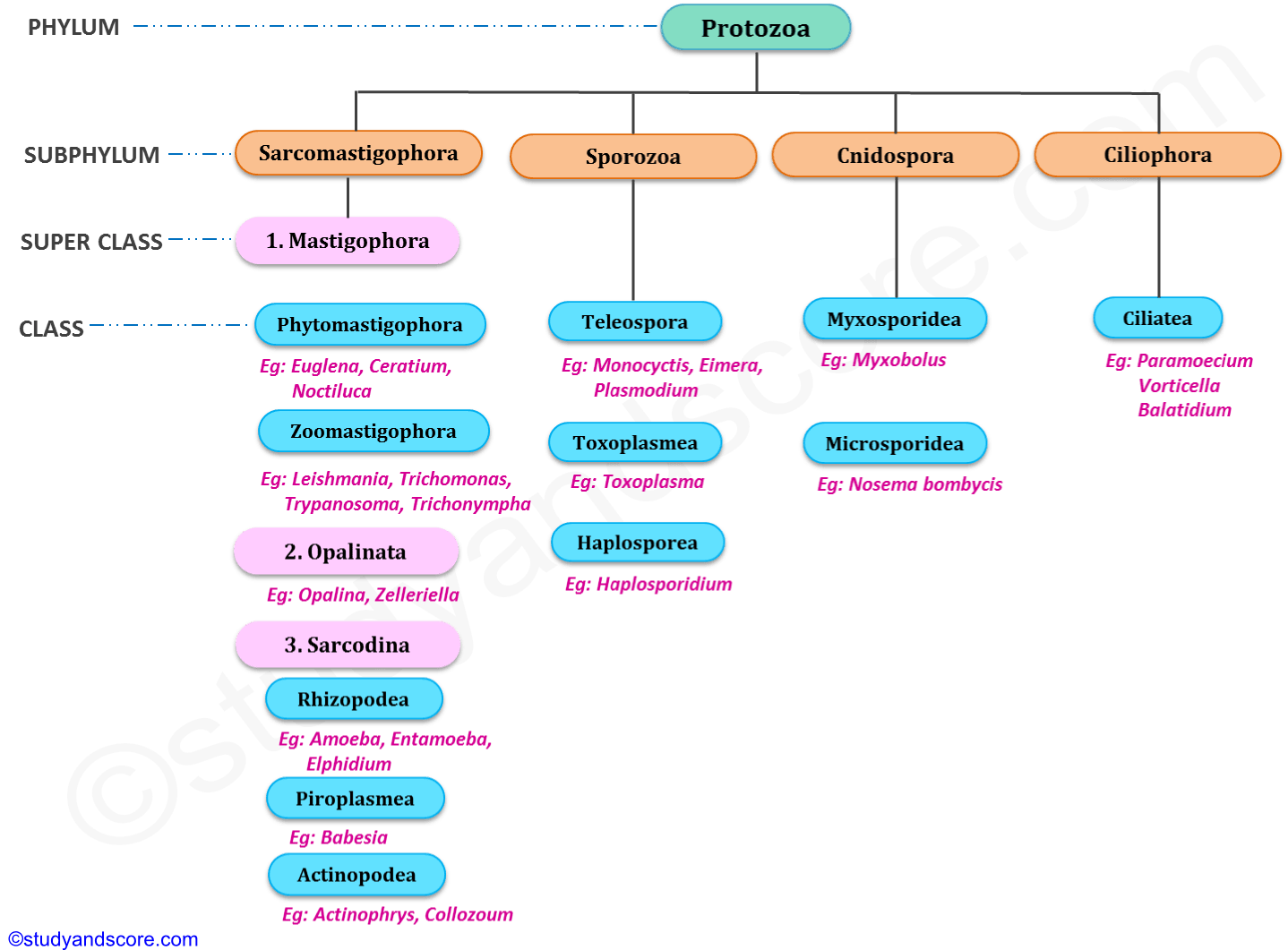The animals included in phylum Protozoa can be defined as microscopic and acellular animalcules without tissues and organs. They have one or more nuclei. Protozoa exist either singly or in colonies. Almost about 50,000 species are known till date.
Anton Van Leeuwenhoek was the first to observe protozoa (Vorticella convellaria) under a microscope. He called them animalcules. Gold fuss coined the term Protozoa which in Greek means first animals (Proto= first; zoans=animals). Hyman and other zoologists preferred to call them as acellular animals.
The body of protozoans is unicellular. They are generally referred to as acellular rather than unicellular as the so called single cell performs all the life activities. Though it is structurally equivalent to a single cell of the metazoan body, it is functionally equivalent to the whole metazoan animals.
Phylum Protozoa is a large and varied group. This phylum has a number of problems in its classification. As per one of the classification given out by Hyman, Hickman and Storer, this phylum is divided into two subphyla on the basis of organs of locomotion. These two subphyla are further divided into 5 classes.
Most accepted classification of protozoa is given by BM Honigberg and others based on the scheme given by the committee on Taxonomy and Taxonomic problems of the society of Protozoologists divides this phyla into 4 subphyla.

The following is the classification as proposed by Honigberg and his group.
SUBPHYLUM I: SARCOMASTIGOPHORA (Gr. Sarcodes=fleshy; mastix=whip; phoros=bearing)
The locomotion in this subphylum is brought about by flagella or pseudopodia or both. Other important feature of this subphylum is the presence of monomorphic nuclei. This subphylum is further divided in to 3 super classes:
Superclass 1: Mastigophora (Gr. Mastix=whip; phoros=bearing)
The body of the animals belonging to this super class is covered by pellicle. The locomotory organelles are flagella. In this super class the asexual reproduction occurs by longitudinal binary fission. This super class includes 2 classes:
Class 1: Phytomastigophora (Gr. Phyton=plant; Mastix=whip; phoros=bearing)
They have chromatophores with chlorophyll. The nutrition in these organisms is mainly holophytic which takes place by phototrophy. These are free living organisms. The reserve food in these organisms is starch or paramylon. These organisms may have 1 or 2 flagella.
Ex: Euglena, Ceratium, Noctiluca
Class 2: Zoomastigophora (Gr. Zoon=animal; Mastix=whip; phoros=bearing)
These organisms do not have chlorophyll bearing chromatophores. These are mostly parasitic. The nutrition in these organisms is holozoic or saprozoic. The reserved food is glycogen. They may have one to many flagella.
Ex: Leishmania, Trypanosoma, Trichomonas, Trichonympha
Superclass 2: Opalinata
The organisms belonging to this super class live as commensals or parasites in the gut of anurans. Their body is covered by oblique rows of cilia-like flagella. These organisms may have 2 or many nuclei also the nuclei are monomorphic. They undergo asexual reproduction by binary fission or by syngamy. Sexual reproduction takes place by anisogamy.
Ex: Opalina, Zelleriella
Superclass 3: Sarcodina (Gr. Sarcode=fleshy)
The locomotion in the organism belonging to this superclass is brought about by pseudopodia. Their body is amoeboid without definite pellicle. The nutrition is holozoic or saprozoic. This super class is further divided into 3 classes:
Class 1: Rhizopodea (Gr. Zoon=animal; Mastix=whip; phoros=bearing)
The pseudopodia of the animals in this class are in the form of lobopodia, filopodia or reticulopodia without axial filaments. This class includes amoebas, foraminiferans and mycetozoans. These animals are mostly free living and a few are also parasitic. In amoebas, the body is naked; in foraminiferans the body is covered by porous calcareous shell.
Ex: Amoeba, Entamoeba, Elphidium
Class 2: Piroplasmea
The animals belonging to this class are parasitic. Locomotory structures are absent in this class. Spores are also absent. These are the small parasites in the red blood cells of vertebrates.
Ex: Babesia
Class 3: Actinopodea (Gr. Actis=ray; podos=foot)
The pseudopodia of the animals belonging to this class are in the form of axopodia with axial filaments, radiating from the spherical body. These are planktonic. This class includes Heliozoans, Radiolarians and acanthareans. Radiolarians and acanthareans are marine forms whereas heliozoans are both marine and fresh water forms. Skeletons of radiolarians have siliceous shells. The shells of dead radiolarians accumulate on the ocean floor to form radiolarian ooze.
Ex: Collozoum, Actinophrys, Acanthometra
SUBPHYLUM II: SPOROZOA (Gr. Actis=ray; podos=foot)
The animals belonging to this subphylum are exclusively endoparasites. Special locomotory organelles are absent in these animals. Sometimes pseudopodia are present which are useful only for ingestion of food. Sporozoites are merozoites bear anterior apical complex that helps penetrate host cells. This subphylum includes 3 classes:
Class 1: Telosporea
The Sporozoites are long in these animals. Reproduction is both asexual and sexual. They are blood and gut parasites of vertebrates. Sexual reproduction is by isogamy or anisogamy.
Ex: Monocyctis, Eimera, Plasmodium
Class 2: Toxoplasmea
In this class reproduction is only asexual type which takes place by internal budding where two daughter cells are produced within the mother cell and the mother cell is finally destroyed in the process of reproduction. Spores are absent.
Ex: Toxoplasma
Class 3: Haplosporea
The spores in this class are amoeboid. Also reproduction is only asexual type taking place through multiple fissions.
Ex: Haplosporidium, Ichthyosporidium
SUBPHYLUM III: CNIDOSPORA (Gr. Knide=nettle; spora=seed)
The animals belonging to this subphylum are parasitic. Special kind of locomotory organelles are absent in these animals. Spores are present with one or more polar filaments. Polar filaments are special and unique features of these animals. When these spores infect a host, the polar filament is discharged and it gets attached to the host tissue. This subphylum includes 2 classes:
Class 1: Myxosporidea
The spores of the animals of this class are large and develop from several nuclei. These are generally extracellular parasites. The spores of this class have two polar filaments and have two to three valves
Ex: Myxobolus
Class 2: Microsporidea
The spores of the animals of this class are small and are developed from only one nucleus. These spores have single valve. These are generally intracellular parasites. Many of the animals of this class have a single polar filament.
Ex: Nosema bombycis
SUBPHYLUM IV: CILIOPHORA (La. Cilium=eye lid with lashes; phoros=bearing)
Ciliophorans are complex of all the protozoans. The locomotory organelle of all the animals of this subphylum is cilia. These cilia also help in feeding at some stage of the life cycle of the animals. The nuclei of these organisms are dimorphic. Macronucleus is vegetative and polyploid. Micronucleus is reproductive and diploid. Asexual reproduction takes place by binary fission. Sexual reproduction takes place by conjugation. Only one class is included in this subphylum:
Class 1: Ciliatea
The locomotory organelles of these animals are numerous hair-like cilia. One or more contractile vacuoles are present in these forms. The nucleus is dimorphic including both macro nucleus and micronucleus.
Ex: Paramoecium, Vorticella, Balatidium

- Share with your friends! -

Study Score on Sep 30, 2018 at 01:51 pm
Entamoeba histolytica causes Amebiasis. Amebiasis is most common in people living with poor sanitation. The infective cyst stage exists only in the host and in fresh loose feces of the infected person. The infection can occur when a healthy person swallows anything contaminated with feces of an infected person. When cysts are swallowed they cause infections by ex-cysting and releasing the trophozoite stage into the digestive tract. So basically Entamoeba resides in the DIGESTIVE TRACT and causes Amebiasis.
Login to post your comment here...
- or with social Account -